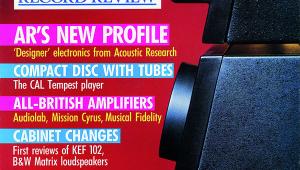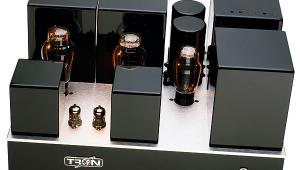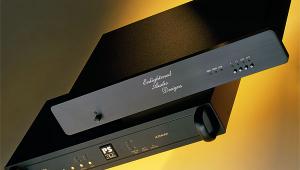Simply The Best Page 2
Computer Buffs
When it comes to the DACs, four Burr-Brown PCM1702 chips are used in current output mode, two per channel in a differential arrangement providing close on 21-bit replay resolution. Current-to-voltage conversion is carried out by the Burr-Brown OPA606 IC, while the quarter ampere power buffers Wadia has chosen to use are zero feedback BUF 634 monolithics.
The balanced outputs are the 'direct' mode with a simple LC filter present at the output. For the unbalanced outputs the main signals are summed in a further OPA606 for full data resolution, feedback connected to another power buffer. These 'follower' type buffers have an extraordinary 2000V/μsec slew rate, for what it's worth. For computer buffs the internal processing rate is equivalent to a very high 80mips; the main digital audio highway, which includes S/PDIF, is 24-bit rated, while the math is computed to 56-bit resolution – a processing headroom of 336dB to be specific.
![]() Out Of The Park
Out Of The Park
The Wadia 16 was plugged directly into power amplifiers via balanced van den Hul 'The Second' cables. A Krell KSA200-S and Meridian 605 were both used to drive Wilson WATT 3/Puppy 2 loudspeakers with auxiliary speakers including the Quad ESL63 and the Monitor Audio Studio 50s. The 16 was also used via an ARC LS7 preamp in balanced mode, and this was a combination I found to be very effective.
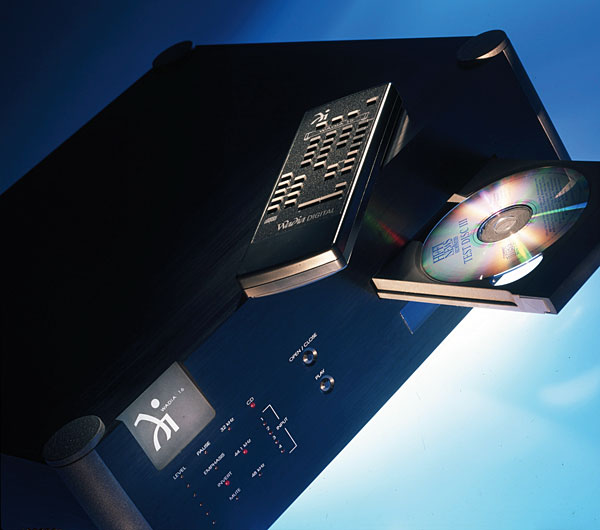
The integrated CD sources available for comparison included Accuphase's DP-70V, Sonic Frontiers' SFD2 and the Orelle DA180. I also made reference to the Levinson 30/31, Wadia 7/9 and Krell MD10-64x high-end, two-box CD players.
I first heard the Wadia 16 briefly before its official UK trade launch and initial results were favourable. This review concentrates on a unit drawn from the first serial production run. A heatsink fitted to the production processor protected it from overheating, the cause of audible clipping in the early sample that I had used at the outset of the review. The production 16 sounded as good as the first time I'd heard the early sample.
I have, however, one word of caution. In unbalanced mode, the 16 generated a mighty bang if switched off, or if the power cord was pulled. There is no hard muting on the output for switch-off – a surprising omission at this price level. In balanced output mode, the turn-off transient was itself balanced and the effect less severe.
While on this subject, listening tests established that the balanced and unbalanced outputs sounded different, and significantly so. The unbalanced signal had a touch of hardness and digital 'brightness' when judged in this elevated territory while the balanced output had an excellent tonal quality, and a very good dynamic quality, which I've found to be something of a Wadia trademark
Fans of the brand will not be disappointed by the Wadia 16's transparency, which is truly state-of-the-art. I swear it compares directly with the reference standard set by the company's 7/9 combination! When you first hear such soundstage depth and crystalline clarity it makes you think again about the entire performance boundaries of the CD medium. That superb clarity and resolution was a continuing reward throughout all the time I was working with the Wadia 16.
Slam Dunk
Soundstage width was also first-rate, with excellent focus and very, very good perspectives. The stereo image was highly stable, and undisturbed by inharmonic noises, audible distortion or spectral imbalances.
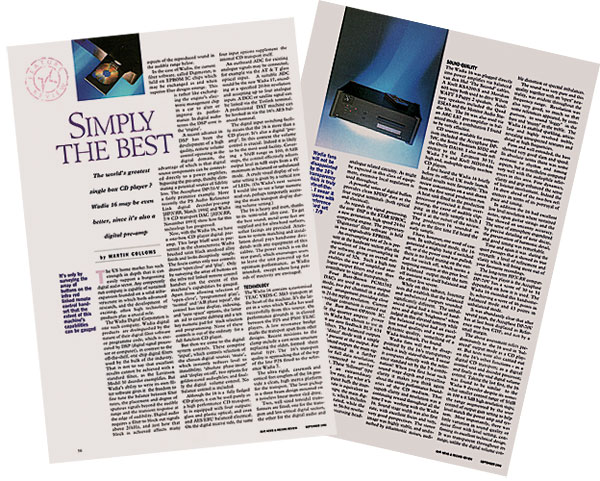
The sound was also very pure and this quality together with an 'open' neutrality, was evident throughout the frequency range. Resolution was also very good, so much so that some references appeared, by comparison, to sound 'foggy' in the bass and 'muzzy' in the treble. The Wadia 16 enabled sparkling, articulate and highly resolved treble, revealing unsuspected textures and detail at high frequencies.
Firm and well extended, the bass showed very good slam and speed. Yes, in absolute terms there was some restraint to both rhythm and timing aspects, but the Wadia 16 nonetheless compared very well with the audiophile references in this area. Fine dynamics, clarity and grip enhanced the sense of listener involvement and the 16 drew ahead of the two-box references here.
Uncanny Accuracy
In addition, the 16 had excellent low-level resolution where sustained notes, open guitar strings and the like showed an uncanny accuracy. The sense of atmosphere engendered by precise detailing of note decay, the preservation of harmonic detail, and good timing was nothing short of remarkable. Time and again it was during the quiet passages that it showed its true strength: a level of refinement and clarity which will bring more out of your favourite recordings.
The long-term HFN comparison one-box player is the Accuphase DP-70V. It was abundantly clear that after several years, this has at last been displaced, and not by a small margin. The above assessment refers predominantly to the 16 used in 'balanced' output mode as a CD player. But tests were also carried out on the 16's other functions – as a digital CD transport, as a digital control unit and decoder processor, and finally as the vital digital volume control. Taking the last function first, the 16 was found to be similar to the Wadia 9 decoder despite its somewhat smaller control range of 50dB in 100x0.5dB high-resolution steps, the range augmented by the user control of output gain setting in order to help level match the power amplifier and system.
Most importantly, there was little variation in sound quality or noise floor with level setting, confirming its excellent technical design. It was transparent throughout its range, unlike the digital volume control used in the Accuphase DP-70V.
As to its performance as a DAC, the Wadia 16 was effective when fed a wide range of digital signals, delivering the highest quality I have as yet heard from both DAT and satellite sources. Indeed, you could even connect a budget CD player and still enjoy much of the 16's replay quality.
Finally I found it set a very high standard as a digital transport, close to the top references including the Wadia 7. It was characterised by clean clarity, strong and open extended bass and transparent, high-definition treble. What's more, the sound was strong and dynamic. Clearly the transport provides a solid foundation for the 16 when used as a CD player.
Conclusion
The Wadia 16 justly takes the title 'Reference Single Box CDP'. Its performance is absolutely first-rate. As for an assessment of the 16 in value for money terms, its considerable versatility as a digital control centre must be taken into account. It has four inputs and output selections including two in the costly glass optical format. As a digital source it is clearly a high grade transport and likewise, its digital decoding function is extremely good. And then there is the high-resolution digital volume control which makes the 16 a digital preamp, allowing direct, low loss connection to power amps.
The 16's sound quality places it at the leading edge, beyond which only small improvements can be expected, even for very large additional expenditure. If you heard the 16 you might wonder how more expensive flagships can be justified.
Easy Does It
On the debit side, the buttons on the remote control could have been laid out much better and I feel that the remote infrared signal should be more powerful. The handset could also be more substantially built considering the price of the player. While I'm on this subject, a better display of volume settings would be welcome, plus a couple more front panel controls, say for volume and input selection. After all, these are major facilities! And then there is that switch-off thump!
As for lab performance, this was exemplary. Accuracy was high, while resolution and dynamic range were excellent. Also, very powerful audio output buffers ensure excellent system compatibility. The only concern was a moderate level of low order 'analogue' distortion near full output, but this was a minor one.
The Wadia 16's very fine sound quality is both memorable and unmistakable. In the context of high-end two-box models it is something of a bargain. Indeed in the 16's sense of ease, purity and coherence it actually outperforms the bigger flagships.







